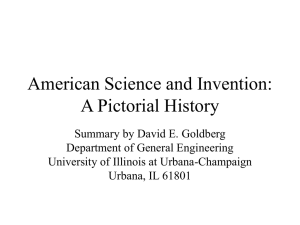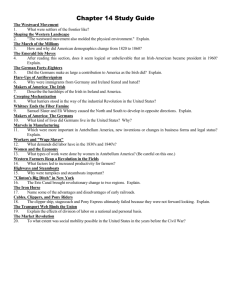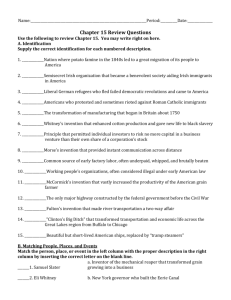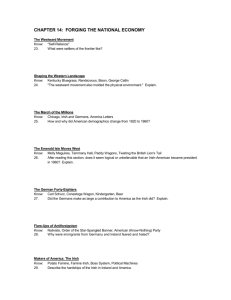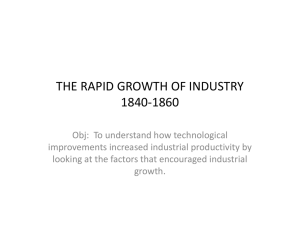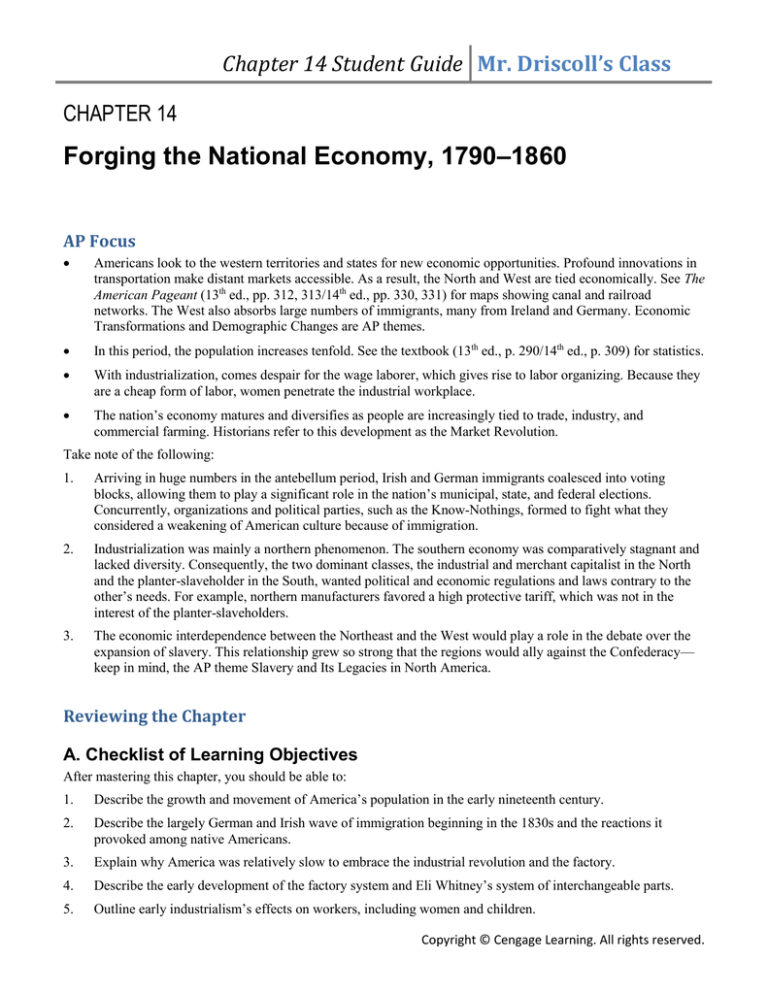
Chapter 14 Student Guide Mr. Driscoll’s Class
CHAPTER 14
Forging the National Economy, 1790–1860
AP Focus
Americans look to the western territories and states for new economic opportunities. Profound innovations in
transportation make distant markets accessible. As a result, the North and West are tied economically. See The
American Pageant (13th ed., pp. 312, 313/14th ed., pp. 330, 331) for maps showing canal and railroad
networks. The West also absorbs large numbers of immigrants, many from Ireland and Germany. Economic
Transformations and Demographic Changes are AP themes.
In this period, the population increases tenfold. See the textbook (13th ed., p. 290/14th ed., p. 309) for statistics.
With industrialization, comes despair for the wage laborer, which gives rise to labor organizing. Because they
are a cheap form of labor, women penetrate the industrial workplace.
The nation’s economy matures and diversifies as people are increasingly tied to trade, industry, and
commercial farming. Historians refer to this development as the Market Revolution.
Take note of the following:
1.
Arriving in huge numbers in the antebellum period, Irish and German immigrants coalesced into voting
blocks, allowing them to play a significant role in the nation’s municipal, state, and federal elections.
Concurrently, organizations and political parties, such as the Know-Nothings, formed to fight what they
considered a weakening of American culture because of immigration.
2.
Industrialization was mainly a northern phenomenon. The southern economy was comparatively stagnant and
lacked diversity. Consequently, the two dominant classes, the industrial and merchant capitalist in the North
and the planter-slaveholder in the South, wanted political and economic regulations and laws contrary to the
other’s needs. For example, northern manufacturers favored a high protective tariff, which was not in the
interest of the planter-slaveholders.
3.
The economic interdependence between the Northeast and the West would play a role in the debate over the
expansion of slavery. This relationship grew so strong that the regions would ally against the Confederacy—
keep in mind, the AP theme Slavery and Its Legacies in North America.
Reviewing the Chapter
A. Checklist of Learning Objectives
After mastering this chapter, you should be able to:
1.
Describe the growth and movement of America’s population in the early nineteenth century.
2.
Describe the largely German and Irish wave of immigration beginning in the 1830s and the reactions it
provoked among native Americans.
3.
Explain why America was relatively slow to embrace the industrial revolution and the factory.
4.
Describe the early development of the factory system and Eli Whitney’s system of interchangeable parts.
5.
Outline early industrialism’s effects on workers, including women and children.
Copyright © Cengage Learning. All rights reserved.
Chapter 14 Student Guide Mr. Driscoll’s Class
6.
Describe the impact of new technologies, including transportation and communication systems, on American
business and agriculture.
7.
Describe the development of a continental market economy and its revolutionary effects on both producers
and consumers.
8.
Explain why the emerging industrial economy could raise the general level of prosperity, while
simultaneously creating greater disparities of wealth between rich and poor.
B. Glossary
To build your social science vocabulary, familiarize yourself with the following terms.
1.
caste An exclusive or rigid social distinction based on birth, wealth, occupation, and so forth. “There was
freedom from aristocratic caste and state church. . . .”
2.
nativist One who advocates policies favoring native-born citizens and displays hostility or prejudice toward
immigrants. “The invasion of this so-called immigrant ‘rabble’. . . inflamed the prejudices of American
‘nativists.’ ”
3.
factory A large establishment for the manufacturing of goods, including buildings and substantial machinery.
“The factory system gradually spread from England—‘the world’s workshop’—to other lands.”
4.
trademark A distinguishing symbol or word used by a manufacturer on its goods, usually registered by law
to protect against imitators. “. . . unscrupulous Yankee manufacturers . . . learned to stamp their own products
with faked English trademarks.”
5.
patent The legal certification of an original invention, product, or process, guaranteeing its holder sole rights
to profits from its use or reproduction for a specified period of time. “For the decade ending in 1800, only 306
patents were registered in Washington. . . .”
6.
liability Legal responsibility for loss or damage. “The principle of limited liability aided the concentration of
capital. . . .”
7.
incorporation The organization of individuals into an institutional entity with legally defined privileges and
responsibilities. “Laws of ‘free incorporation’ were first passed in New York in 1848. . . .”
8.
labor union An organization of workers—usually wage-earning workers—to promote the interests and
welfare of its members, often by collective bargaining with employers. “They were forbidden by law to form
labor unions. . . .”
9.
strike An organized work stoppage by employees in order to obtain better wages, working conditions, and so
on. “Not surprisingly, only twenty-four recorded strikes occurred before 1835.”
10. capitalist An individual or group who uses its accumulated funds or private property to produce goods or
services for profit in a market. “It made ambitious capitalists out of humble plowmen. . . .”
11. turnpike A toll road. “The turnpikes beckoned to the canvas-covered Conestoga wagons. . . .”
12. posterity Later descendants or subsequent generations. “He installed a powerful steam engine in a vessel that
posterity came to know as the Clermont. . . .”
13. productivity In economics, the relative efficiency in the production of goods and services, measured in terms
of the quantity of goods or services produced by workers in a certain length of time. “The principle of division
of labor . . . spelled productivity and profits. . . .”
14. barter The direct exchange of goods or services for one another, without the use of cash or any other medium
of exchange. “Most families . . . bartered with their neighbors for the few necessities they could not make
themselves.”
Copyright © Cengage Learning. All rights reserved.
Chapter 14 Student Guide Mr. Driscoll’s Class
Chapter Themes
Theme: The importance of the West grew in the early nineteenth century. Cheap land attracted immigrants and
natives alike, and after some technological innovations, the West became an agricultural giant. The increased
output also spurred transportation developments to tie this developing region to the rest of the United States.
Theme: In the era of Jacksonian democracy, the American population grew rapidly and changed in character. More
people lived in the raw West and in the expanding cities, and immigrant groups, like the Irish and Germans, added
their labor power to America’s economy, sometimes arousing hostility from native-born Americans in the process.
Theme: In the early nineteenth century, the American economy developed the beginnings of industrialization. The
greatest advances occurred in transportation, as canals and railroads bound the Union together into a continental
economy with strong regional specialization.
CHAPTER SUMMARY
The youthful American republic expanded dramatically on the frontier in the early nineteenth century. Frontier life
was often crude and hard on the pioneers, especially women.
Westward-moving pioneers often ruthlessly exploited the environment, exhausting the soil and exterminating
wildlife. Yet the wild beauty of the West was also valued as a symbol of American national identity, and
eventually, environmentalists would create a national park system to preserve pieces of the wilderness.
Other changes altered the character of American society and its workforce. Old cities expanded, and new cities
sprang up in the wilderness. Irish and German immigrants poured into the country in the 1830s and 1840s, and the
Irish, in particular, aroused nativist hostility because of their Roman Catholic faith.
Inventions and business innovations, such as free incorporation laws, spurred economic growth. Women and
children were the most exploited early factory laborers. Male workers made some gains in wages and hours but
generally failed in unionization attempts.
The most far-reaching economic advances before the Civil War occurred in agriculture and transportation. The
early railroads, despite many obstacles, gradually spread their tentacles across the country. Foreign trade remained
only a small part of the American economy, but changing technology gradually created growing economic links to
Europe. By the early 1860s, the telegraph, railroad, and steamship had gone far toward replacing older means of
travel and communication such as the canals, clipper ships, stagecoach, and pony express.
The new means of transportation and distribution laid the foundations for a continental market economy. The new
national economy created a pattern of sectional specialization and altered the traditional economic functions of the
family. There was growing concern over the class differences spawned by industrialization, especially in the cities.
But the general growth of opportunities and the increased standard of living made America a magnetic land of
opportunity to many people at home and abroad.
character sketches
Eli Whitney (1765–1825)
Whitney was the American inventor whose two major innovations—the cotton gin and the system of
interchangeable parts—revolutionized the American economy.
He did not care for school, preferring to spend his time making and fixing things in his father’s shop. Whitney once
took his father’s watch completely apart and reassembled it without his father discovering the deed. For a time, he
supported himself by manufacturing nails and hatpins.
He earned money to attend Yale by fixing things around the college. One campus carpenter allegedly said, “There
was a good mechanic spoiled when you went to college.”
Copyright © Cengage Learning. All rights reserved.
Chapter 14 Student Guide Mr. Driscoll’s Class
He built the first cotton gin in ten days and a larger model in a year. The original machine was stolen and imitations
were produced; it took Whitney many years of legal battles to gain the sole patent for the device.
Quote: “There were a number of very respectable Gentlemen at Mrs. Greene’s who all agreed that if a machine
could be invented which would clean the cotton with expedition, it would be a great thing both to the country and to
the inventor.… I concluded to relinquish my school and turn my attention to perfecting the Machine. I made one
before I came away which required the labor of one man to turn it and with which one man will clean ten times as
much cotton as he can in any other way before known.…” (Letter to his father, 1793)
REFERENCE: Constance M. Green, Eli Whitney and the Birth of American Technology (1956).
Robert Fulton (1765–1815)
Fulton is best known in America for his development of the steamboat, but he was also a successful artist and an
inventor of the submarine and the torpedo.
As a boy, Fulton became a skilled gunsmith, and in school, he made his own pencils. He liked to fish but hated to
row boats, so at fourteen, he devised a paddle wheel to move the boat by foot.
A talented artist, he studied in London under Benjamin West and was earning a successful living by painting before
he turned to mechanics and engineering.
He first worked in Britain on iron aqueducts and bridges, and then went to France, where he built a diving boat, the
Nautilus, which could stay underwater for four hours. But Napoleon lost interest in the device when it proved
unable to sink British shipping.
His first steamboat sank on the Seine, but a second model, built in 1803, was successful. This became the prototype
for the Clermont.
Quote: “When [the Clermont] came so near that the noise of the machine and paddles were heard…some prostrated
themselves and besought Providence to protect them from the approach of the horrible monster which was
marching on the wave and lighting its path by spitting fire.” (Newspaper account of the Clermont’s first voyage,
1807)
REFERENCE: Kirkpatrick Sale, Fire of His Genius: Robert Fulton and the American Dream (2001).
Samuel F. B. Morse (1791–1872)
Morse, the inventor of the telegraph, was also a superb American painter and was, for a time, a leader of nativist
agitation.
He studied painting in England, with some of his work winning prizes in the Royal Academy competitions. He
returned to Boston in 1815 but discovered that he could earn a living only by painting portraits. After Congress
rejected his plan to paint the Capitol rotunda, he reluctantly abandoned art and turned to inventing.
From his time in Europe, he had developed a strong dislike of Catholicism, and in the 1830s, he was a leader of
American anti-Catholic agitation.
He developed the first ideas for the telegraph from hearing lectures on electricity. But it took several years of
experimentation to perfect the sending and receiving devices and to develop his Morse code for communicating
messages by short and long signals. He was in continual poverty and was nearly at the point of abandoning the
project when Congress finally authorized funds for the successful Baltimore-to-Washington line.
Quote: “If the presence of electricity can be made visible in any part of an electric circuit closed by an
electromagnet, I see no reason why intelligence may not be transmitted instantaneously by electricity.” (1832)
REFERENCE: Carleton Mabee, American Leonardo: A Life of Samuel F.B. Morse (1943).
Copyright © Cengage Learning. All rights reserved.

